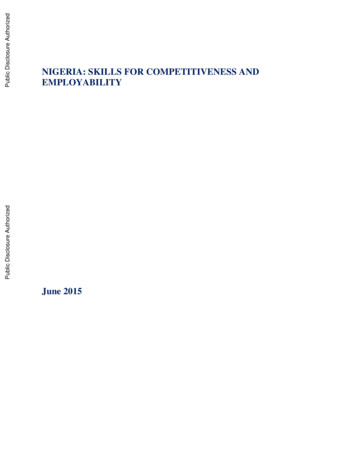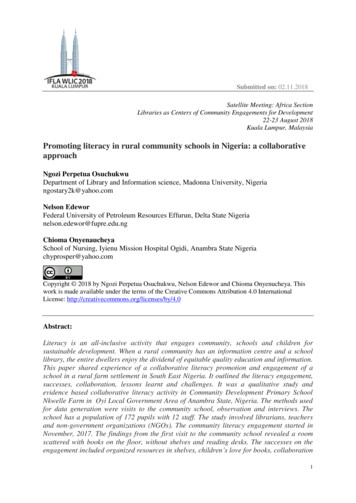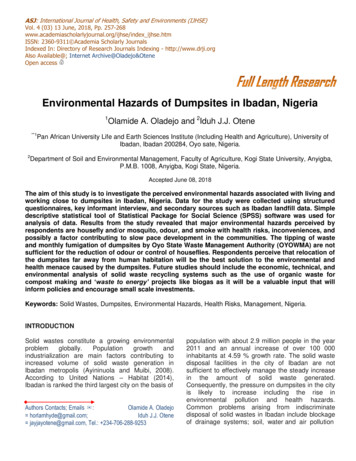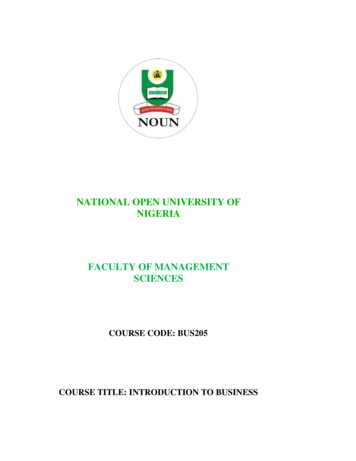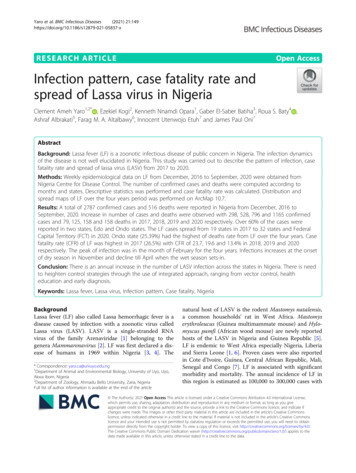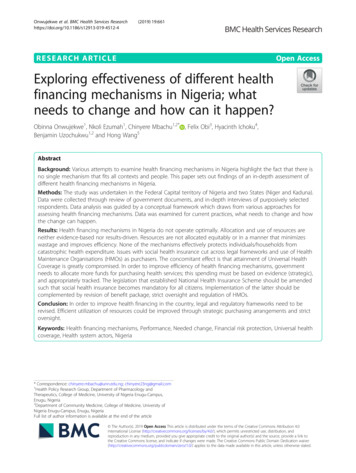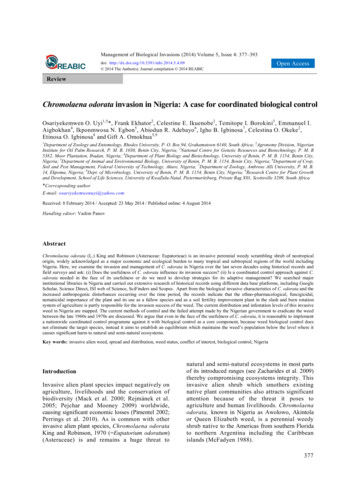
Transcription
Management of Biological Invasions (2014) Volume 5, Issue 4: 377–393doi: http://dx.doi.org/10.3391/mbi.2014.5.4.09 2014 The Author(s). Journal compilation 2014 REABICOpen AccessReviewChromolaena odorata invasion in Nigeria: A case for coordinated biological controlOsariyekemwen O. Uyi1,5*, Frank Ekhator 2, Celestine E. Ikuenobe2, Temitope I. Borokini3, Emmanuel I.Aigbokhan 4, Ikponmwosa N. Egbon 5, Abiodun R. Adebayo 6, Igho B. Igbinosa7, Celestina O. Okeke 2,Etinosa O. Igbinosa8 and Gift A. Omokhua5,91Department of Zoology and Entomology, Rhodes University, P. O. Box 94, Grahamstown 6140, South Africa; 2Agronomy Division, NigerianInstitute for Oil Palm Research, P. M. B. 1030, Benin City, Nigeria; 3National Centre for Genetic Resources and Biotechnology, P. M. B5382, Moor Plantation, Ibadan, Nigeria; 4Department of Plant Biology and Biotechnology, University of Benin, P. M. B. 1154, Benin City,Nigeria; 5Department of Animal and Environmental Biology, University of Benin, P. M. B. 1154, Benin City, Nigeria; 6Department of Crop,Soil and Pest Management, Federal University of Technology, Akure, Nigeria; 7Department of Zoology, Ambrose Alli University, P. M. B.14, Ekpoma, Nigeria; 8Dept. of Microbiology, University of Benin, P. M. B. 1154, Benin City, Nigeria; 9Research Centre for Plant Growthand Development, School of Life Sciences, University of KwaZulu-Natal, Pietermaritzburg, Private Bag X01, Scottsville 3209, South Africa*Corresponding authorE-mail: osariyekemwenuyi@yahoo.comReceived: 8 February 2014 / Accepted: 23 May 2014 / Published online: 4 August 2014Handling editor: Vadim PanovAbstractChromolaena odorata (L.) King and Robinson (Asteraceae: Eupatorieae) is an invasive perennial weedy scrambling shrub of neotropicalorigin, widely acknowledged as a major economic and ecological burden to many tropical and subtropical regions of the world includingNigeria. Here, we examine the invasion and management of C. odorata in Nigeria over the last seven decades using historical records andfield surveys and ask: (i) Does the usefulness of C. odorata influence its invasion success? (ii) Is a coordinated control approach against C.odorata needed in the face of its usefulness or do we need to develop strategies for its adaptive management? We searched majorinstitutional libraries in Nigeria and carried out extensive research of historical records using different data base platforms, including GoogleScholar, Science Direct, ISI web of Science, SciFinders and Scopus. Apart from the biological invasive characteristics of C. odorata and theincreased anthropogenic disturbances occurring over the time period, the records indicate that the ethno-pharmacological, funcigicidal,nematicidal importance of the plant and its use as a fallow species and as a soil fertility improvement plant in the slash and burn rotationsystem of agriculture is partly responsible for the invasion success of the weed. The current distribution and infestation levels of this invasiveweed in Nigeria are mapped. The current methods of control and the failed attempt made by the Nigerian government to eradicate the weedbetween the late 1960s and 1970s are discussed. We argue that even in the face of the usefulness of C. odorata, it is reasonable to implementa nationwide coordinated control programme against it with biological control as a core component, because weed biological control doesnot eliminate the target species, instead it aims to establish an equilibrium which maintains the weed’s population below the level where itcauses significant harm to natural and semi-natural ecosystems.Key words: invasive alien weed, spread and distribution, weed status, conflict of interest, biological control, NigeriaIntroductionInvasive alien plant species impact negatively onagriculture, livelihoods and the conservation ofbiodiversity (Mack et al. 2000; Rejmánek et al.2005; Pejchar and Mooney 2009) worldwide,causing significant economic losses (Pimentel 2002;Perrings et al. 2010). As is common with otherinvasive alien plant species, Chromolaena odorataKing and Robinson, 1970 ( Eupatorium odoratum)(Asteraceae) is and remains a huge threat tonatural and semi-natural ecosystems in most partsof its introduced ranges (see Zacharides et al. 2009)thereby compromising ecosystems integrity. Thisinvasive alien shrub which smothers existingnative plant communities also attracts significantattention because of the threat it poses toagriculture and human livelihoods. Chromolaenaodorata, known in Nigeria as Awolowo, Akintolaor Queen Elizabeth weed, is a perennial weedyshrub native to the Americas from southern Floridato northern Argentina including the Caribbeanislands (McFadyen 1988).377
O.O. Uyi et al.Following its introduction from Sri Lanka intosouthern Nigeria in 1937 (Ivens 1974), it hasreached alarming proportions in Nigeria (Lucas1989; Uyi et al. 2013; Uyi and Igbinosa 2013),Cameroon, Ghana, and other parts of Africa(Zachariades et al. 2009; 2013), and is now oneof the worst weeds in Nigeria and West Africa.The biotype of C. odorata found in West andCentral Africa differs from the invasive formfound in South Africa, in both morphology andaspects of its ecology (Zachariades et al. 2009;Paterson and Zachariades 2013) and is thought tooriginate from Trinidad, Tobago and adjacent areasin the West Indies. The southern African C. odoratabiotype is not the subject of this paper. Thebiology and ecology of both biotypes of C. odoratahas been well documented (see Holm et al. 1977;Gautier 1992; Witkowski and Wilson 2001;Rambuda and Johnson, 2004) and reviewed inZachariades et al. (2009).Because of its presence over large areas andits invasive nature, the application of chemicaland mechanical control methods is not sustainablein terms of cost and practicability, hencebiological control of the weed was attempted inNigeria in the 1970s (Cock and Holloway 1982),but this effort was not successful (Julien andGriffiths 1998). Following the unsuccessful controlattempts, biologists, ecologists, conservationists,agriculturists and non-professionals in the countryhave continuously differed on the best way torespond to the C. odorata invasion, partly becausethe weed is thought to offer a variety of benefits.For example, many publications describe theimportance of C. odorata as a fallow species inslash and burn fallow rotations practiced by farmersin the country (e.g. Akobundu and Ekeleme 1996;Tian et al. 1998; Akobundu et al. 1999; Tian etal. 2005) and there are also many publications onits medicinal uses in several parts of the country(e.g. Odugbemi et al. 2007; Ajao et al. 2011;Alisi et al. 2011). Furthermore, the importanceof the weed in livestock nutrition, improvementof soil fertility and its potential use as a pesticidehas been reported (see references in Table 1).At present, there are no control or managementefforts in place to check the spread of the weedin Nigeria. With the exception of the earlierpublications by Ivens (1974) and Lucas (1989),we are not aware of any later attempt to reviewand/or assess the invasiveness and status of C.odorata in Nigeria. Due to the perceived usefulnessof C. odorata, the initiation of a control ormanagement programme would require a proper378understanding of its invasion and managementhistory. Here, we examine the invasion (spread anddistribution) and management of C. odorata inNigeria over the last seven decades using historicalrecords and field surveys. We ask: (i) Howrapidly did C. odorata spread and why? (ii) Whatis the current extent of spread and impact? (iii)What attempts were made to control C. odorataand were they successful? (iv) Do the positiveattributes of C. odorata influence the continuousspread of the weed? (v) Is a coordinated controlapproach against C. odorata needed in the faceof its usefulness or do we need to develop strategiesfor its adaptive management? To answer thesequestions, we undertook a thorough literaturesearch using the internet and major institutionallibraries in Nigeria.MethodsWe systematically surveyed between November2011 and December 2013 reports in Universityof Benin and Nigerian Institute for Oil Palm(NIFOR) libraries in Benin City, Nigeria, publishedby Federal Ministry of Agriculture and RuralDevelopment and in national and internationalscientific journals from 1960s until the presentday. Information gathering also involved the useof different data base platforms, including GoogleScholar, Science Direct, ISI web of ScienceSciFinders and Scopus. The eligibility criteriawere deliberately broad in order to ensure that weincluded all relevant materials. All reports andpapers that mention C. odorata and its control inany capacity (for example spread, status, controlmeasures) were included in the selection process.Over one hundred records were identified. Athorough search of these records was carried outto examine the narrative surrounding C. odoratain each record. These records were used to answerthe questions raised earlier.To examine the extent of spread of C. odoratain Nigeria, opportunistic surveys were conductedby the individual authors between 2003 and 2013in different parts of the country; results wereused to map the current distribution of the weed.Results and discussionHistory and current distribution of Chromolaenaodorata in NigeriaThe first collection of C. odorata in Nigeria wasin 1942 from a forestry plantation near Enugu, insouth-eastern Nigeria and is thought to have resulted
Seven decades of Chromolaena odorata invasion in NigeriaTable 1. The status of Chromolaena odorata as a weed versus its usefulness in Nigeria.ReferencesWeedAdebayo (2013)Adebayo and Uyi (2010)Adetoro et al. (1998)Adeyemi (1989)Afolayan (1988)Agamagu et al. (2008)Agbim (1987)Agunbiade and Fawale (2009)Ajao et al. (2011)Akinmoladun et al. (2007)Akinyemiju and Alimi (1989)Akobundu and Agyakwa (1998)Akobundu and Ekeleme (1996)Akobundu et al. (1999)Alisi and Onyeze (2009)Alisi et al. (2011)Amiolemen et al. (2012)Anoliefo et al. 2003Aro and Fajemilehin (2005)Aro et al. (2009)Aweto and Iyanda (2003)Borokini (2011)Egbe and Oladokun (1987)Ekeleme et al. (2004)Ekhator et al. (2013)Ekpa (1996)Etejere (1980)Etejere (1982)Etejere (1983)Etuk (1973)Eze and Gill (1992)Fadiyimu et al. (2005)Fasuyi et al. (2006)Gill et al. (1996)Hoevers and M’boob (1996)Igboh et al. (2009)Ige et al. (2008)Iheagwam (1983)Ikuenobe (1992)Ikuenobe and Anoliefo (2003)Ikuenobe and Ayeni (1998)Ilondu (2011)Ilori et al. (2011)Ivens (1972)Ivens (1973)Ivens (1974)Ivens (1975)Iwu (1993)Jibril and yahaya (2010)Komolafe (1980)Komolafe (1976)Lucas (1989)Nwokolo (1987)Obatolu and Agboola (1993)Odeyemi (1981)Odeyemi et al. (2011)Odugbemi (2006)Odugbemi et al. ************************Author’s submissionsThreat to biodiversity and agricultureImprovement of soil fertilityWeed of plantation cropsThreat to agricultureThreat to agricultureFallow species/improve soil fertilityBiomarker and bioremediationMedicinal plantThreat to agricultureFallow species/improve soil fertilityMedicinal plantImprovement soil fertilityPhyto-remediationLivestock nutritionMedicinal plantFallow speciesThreat to biodiversity conservationThreat to agricultureFallow species/improve soil fertilityThreat to agricultureMedicinal plantAgricultural weedLivestock nutritionWeed of plantation cropsThreat to biodiversity and agricultureMedicinal plant/livestock nutritionAgricultural weedWeed of plantation and arable cropsFallow species/improve soil fertilityWeed of plantation and arable cropsFungicideManureThreat to agricultureMedicinal plantImprovement of soil fertilityThreat to agricultureLivestock nutitionImprovement of soil fertilityBiogasNematicideMedicinal plant-379
O.O. Uyi et al.Table 1 (continued).ReferencesWeedOdukwe (1965)Ogbe et al. 1994Ogundola and Liasu (2007)Oigiangbe et al. (2007)Okeke and Omaliku (1992)Okigba et al. (2010)Olaniyi et al. (2009)Olaoye (1986)Olaoye (1977)Olaoye (1976)Olaoye and Egunjobi (1974)Onwugbuta-Enyi (2001)Otoikhian and Oyefa (2010)Owolabi et al. (2010)Riddock et al. (1991)Sheldrick (1968a)Smith and Alli (2005)Taiwo et al. (2000)Tian et al. (2005)Tian et al. (1998)Utulu (1996)Uyi and Igbinosa (2013)Uyi et al. (2013)Uyi (2011)Uyi et al. (2011)Uyi and Aisagbonhi (2009)Uyi et al. (2008)Yeni et al. (2010)****Total4541Percent52.3247.68Author’s submissionsWeed of agriculture and forestryWeed: allelopathic effectHost of important pests of cropsSoil fertilityFungicideImprovement of soil fertilityThreat to agriculture and forestryImprovement of soil fertilityThreat to agriculture and forestryAllelopathic effects on cropsMedicinal plantMedicinal plant/essential oilWeed: prevent tree seedling growingWeed of plantation cropsThreat to agricultureMedicinal plantFallow plantFallow plantWeed of plantation cropsThreat to biodiversity and agricultureThreat to biodiversity and agricultureThreat to biodiversity and livelihoodsThreat to agricultureFungicide************************from the importation of contaminated seeds ofthe forest tree Gmelina arborea Roxb., 1814(Verbenaceae) from Sri Lanka in 1937 (Ivens 1974).Following its introduction, the weed quicklyspread through eastern Nigeria in the 1940s andwas first reported by Ivens (1974) to the west ofthe river Niger in 1955 and from Lagos and itsenvirons in 1960 (Odukwe 1965) from where itmight have spread into Benin Republic and othercountries in West Africa. By 1960, C. odoratahad occupied the south-eastern states of Nigeria,from where it spread into Cameroon (Hoeversand M’boob 1996). Its rapid spread through theentire southeast in the 1940s to reach the southwestof the country in the 1950s may have been as aresult of regional trade, and human and vehicularmovement especially by the colonial administrationand local politicians at the time. The civil war inNigeria between the late 1960s and early 1970smay have also facilitated the spread of C. odoratafrom the south-eastern region because of the380Beneficialmovement of people, troops and military hardwareduring and after the war. Disturbed soil in forestclearing provides an ideal habitat for the plantand the construction of new roads in the countrythrough the rainforest zones appears to have greatlyinfluenced the distribution of the weed at theearly stages of invasion.The introduction of C. odorata into Nigeriainstigated many local names tied to historical eventsat the time of its occurrence among the locals.For example, the inhabitants of mid-westernNigeria called it “Awolowo” apparently afterChief Obafemi Awolowo, the mercurial politicianof the 1950-60s who conducted his electioneeringcampaigns with helicopter flights into the remotestvillages in Nigeria, a period which coincidedwith the spread of C. odorata weed in the midwestern region. Other areas of the country havedifferent names for it based on other happenstancethat coincided with its appearance or mode ofspread. For example, in Warri area of the Niger
Seven decades of Chromolaena odorata invasion in NigeriaFigure 1. Distribution and infestation levels of Chromolaena odorata in Nigeria.Delta, it is called “Ogbeko” or “Shell-copy” (thelatter literally a corruption of Shell PetroleumDevelopment Company (SPDC) whose oilprospecting activities in the Niger Delta Regioncoincided with the appearance of the weed). Tothe west, the weed is referred to by other namessuch as “Akintola” or “Awolowo”. In easternNigeria, it is called several names among whichare “Obialofulu” and “Queen Elizabeth” indicatingthat the spread of weed might have been widelynoticeable during the period of the queen’s visitto Nigeria in 1956. There is no known local namefor it in the Hausa language which probably isdue to its absence in the drier climes of northernNigeria which is predominantly populated by theHausas.Overall, the invasive success of C. odorata isthought to depend upon the combination of itshigh reproductive capacity, high growth rate andnet assimilation rate (Ramakrishnan and Vitousek1999), its capacity to suppress native vegetationthrough light competition (Kushwaha et al. 1981;Honu and Dang 2000), its allelopathic properties(Gills et al. 1996; Onwugbuta-Enyi 2001) as wellas its ability to grow on many soil types and inmany climatic zones (Timbilla and Braimah 1996;Goodall and Erasmus 1996; Robertson et al. 2008).The results of the surveys conducted between2003 and 2013 in the different regions of Nigeriaindicate that C. odorata is now present in allparts of Nigeria, except in the northeast and farnorth (Figure 1) where the prevailing climaticconditions are probably not suitable for its growthand establishment. Infestations of C. odoratawere rated in three categories viz; (i) high, (ii)medium and (iii) low (Figure 1). In category oneinfestation, C. odorata was present and abundantin all places suitable for its growth, completelysmothering co-occurring vegetation, while incategories two and three infestations, the weedwas less invasive. Infestations of the weed wereobserved in cocoa, rubber, oil palm and coconutplantations, arable crop farms (including cassava),nursery gardens, secondary forests, forest margins,wastelands, abandoned plots, road sides and otherland use types.These surveys showed that the entire southeastern, south-western, Niger Delta and parts ofnorth-central regions have been colonized byC. odorata (Figure 1) and that the weed has381
O.O. Uyi et al.successfully spread to over 23 states of the 36states in Nigeria, and is present in a wide rangeof vegetation zones including rainforest andfresh water swamp forest in the south (annualrainfall 1600 mm) and woodland and grasslandsavannah zones in the north central (where annualrainfall ranges between 900 and 1600 mm).Figure 2 shows the vegetation zones of Nigeriawith total annual rainfall. The rainforest,woodland savannah and fresh water swamp forestzones are particularly vulnerable and severelyaffected, with C. odorata achieving invasivestatus. Chromolaena odorata is now present in theguinea (woodland, grassland and tall grass)savannah states of Nasarawa, Benue, Kebbi,Kwara, Kogi, Plateau, Niger, Taraba and theFederal Capital Territory in Abuja where it hadnot previously been reported. However, thedensity of C. odorata infestations varies in theselocations, ranging from medium to low (Figure1). The situation today is dissimilar to thatreported in the 1980s by Lucas (1989), in that theweed has now spread to large parts of the northcentral region and parts of the northwest inKebbi State. McFadyen (1989) predicted that theminimum annual rainfall requirement forC. odorata was 1200 mm, but a considerablelower limit has been recorded in Chad, Ghanaand South Africa (Goodall and Erasmus 1996;Timbilla 1998; Kriticos et al. 2005). Because ofthe vast land area of the woodland and grasslandsavannah zones in Nigeria, it is believed thatC. odorata is yet to achieve its maximum spreadpotential in the country. The weed range willprobably increase further with change in climateif rainfall increases in the savannah zone.The problems of Chromolaena odorata in NigeriaIn Nigeria and most parts of West Africa,C. odorata impacts on farming, pastoral agriculture, and biodiversity and on human welfare.Chromolaena odorata can easily invade openspaces and heavily disturbed environments suchas croplands and neglected pastures, forest marginsand disturbed rainforests. It competes effectivelywith crops and other plant species and may becomedominant, thus causing loss of ecosystem integrity.Die-back of plants after flowering presents a firerisk during the intense dry season, causing extensiveand frequent bushfires in southern Nigeria (Uyiand Igbinosa 2013). These bushfires impactnegatively on human livelihoods and destroycultivated crops (e.g. cassava, yam, cocoyam, maize,okra) and have resulted in the loss of plantain382and cocoa plantations in southern Nigeria. Thefires may prevent the recruitment of native plantspecies, leading to changes in the structure andcomposition of native flora. For example, teBeest et al. (2012) showed how fire interactedwith the conventional clearing of C. odorata inSouth Africa and induced an intense canopy firethat caused a shift from woodland to grassland.Also McFadyen (2004) reported considerabledamage to surrounding native vegetation due tofire caused by dry stems of C. odorata.Although the arrival and continuous spread ofC. odorata is thought to pose a serious threat tosubsistence and commercial agriculture in Nigeria(Sheldrick 1968; Lucas 1989; and severalreferences in Table 1), very little has been doneto elucidate its full impact on agricultural crops(subsistence or commercial). Future researchwork should be carried out to support or refutespeculations regarding the negative impact of theweed so as to guide stakeholder’s decisions whenconsidering control measures against the weed. Aswith other invasive weed species elsewhere, C.odorata is thought to be a problem in young treecrop plantations (e.g. rubber, oil palm, cocoa andfruit trees), cassava, yam, banana, plantain andother important agricultural crops in southernand central parts of the country.The problem of C. odorata in rubber, cocoa,coconut and oil palm plantations is pronouncedin the early stages of crop establishment, whereits invasion can lead to the shading and smotheringof young crops. Sheldrick (1968) reported thatsevere infestation of oil palm plantations in theearly stage of growth by C. odorata have beenfound to delay fruiting in oil palms for two years.In arable crops, the yield of maize has beenfound to be reduced by C. odorata infestationsby as much as 17% while that of cassava wasreduced by as much as 60–70% (Lucas 1989).Cassava is the most widely grown staple crop inNigeria (FAO 2000) providing the main staplefor most Nigerians especially the resource poorfarmers and rural populations. Some local farmersinterviewed during our survey are of the opinionthat the invasiveness of the weed in rural areasespecially in cassava farms is thought to causeserious apprehension about food and livelihoodsecurity. Chromolaena odorata is thought to impactson crop establishment through competition and/orits allelopathic effects (Gill et al. 1996; OnwugbutaEnyi 2001). For example, Ogbe et al. (1994)reported a strong inhibiting effect of the leafextracts of C. odorata on the growth of maizeseedlings. The most important effect of the weed
Seven decades of Chromolaena odorata invasion in NigeriaFigure 2. Vegetation types inNigeria that are infested or havethe potential to become infestedby Chromolaena odorata. Thetotal annual rainfall ranges in thedifferent vegetation zones areshown on the map.on crop production is probably its high cost ofcontrol, especially on small holdings. In Ghanafor example, management of C. odorata in younginfested plantation crops is known to contributeabout a third of the cost of production (Timbillaet al. 2003). It has been observed that farmers insouth-western Nigeria spend much of their timeand money on the control of this weed (Adebayo2013).In some forest species grown in Nigeria suchas teak Tectona grandis Linnaeus, 1782(Lamiaceae), G. arborea and Terminalia superbaEngl. and Diels, 1900 (Combretaceae), theimpact of C. odorata was minimal (Lucas 1989)and is sometimes not regarded as a problem inforestry plantations (Ivens 1974). However, theremoval of C. odorata has been shown to allowrapid regeneration of indigenous forest in Ghana(Honu and Dang 2000). The weed is known toharbour some important pest of crops notablyZonocerus variegatus (Linnaeus, 1758) (Orthoptera:Pyrgomorphidae) (Boppré 1991; Oigiangbe et al.2007) and Aphis spiraecola Patch, 1914(Homoptera: Aphididae) (Uyi et al. 2008). ThePyrrolizidine alkaloids (PAs) obtained byZ. variegatus from the non-nutritional feeding onC. odorata protect the grasshoppers and theireggs from predators and parasitoids (Boppré1991) leading to increased fitness and populationdensity of this polyphagous pest of crops (includingcassava).In terms of the weed’s impact on biodiversityin Nigeria, we did not find a single empiricalpublished report. The majority of literature(including some of our own papers cited here)(Table 1) referring to C. odorata as a threat tobiodiversity are mainly anecdotal. Therefore,future research should investigate this aspect asit will help elucidate its actual impact on indigenousand non-native species in the country. Elsewherein West and South Africa, the weed has beenreported to impact negatively on biodiversityconservation (Yeboah 1998; Leslie and Spotila2001; Goodman 2003; Mgobozi et al. 2008). Forexample, Yeboah (1998) reported reduced diversityof small mammals in vegetation dominated by C.odorata in comparison to areas without theweed, while in South Africa, Leslie and Spotila(2001) showed how the growth of C. odorataalong riverbanks interfered with the egg-layingof Nile crocodile Crocodylus niloticus Laurenti,1768 (Crocodilia) and altered its sex ratio in theprogeny through shading of nests. The allelopathicproperties of the weed (Sahid and Sugau 1993)383
O.O. Uyi et al.Reasons for the invasion success of Chromolaenaodorata in NigeriaApart from biological factors, human and vehicularmovements and construction of roads as well asthe increased human disturbances associated withthe recent economic growth and infrastructuraldevelopment in the country, several other factorshave been implicated in the continued spread ofC. odorata. For example, while a worldwideeffort is being made to manage the spread of thisnoxious weed (see reviews in Zachariades et al.2009; 2011), some researchers (Table 1) in Nigeriado not see C. odorata as a threat to agricultureand biodiversity conservation because of itsperceived usefulness. This perception alone couldinfluence the continuous spread of the weed intonew areas. To critically review the opinion ofresearchers in Nigeria about the status ofC. odorata, we reviewed over eighty publishedinformation items on C. odorata in Nigeria, dated1965 to 2013, available from a variety of sources(see methods section for details). Fifty-two percentof this published information on C. odorata inNigeria by different researchers strongly regardsC. odorata as a serious threat to agriculture andbiodiversity conservation, while 47.6% reportedC. odorata as either medicinal plant, nutritiveplant for livestock diet, fallow plant in slash andburn rotation agricultural system or soil fertilityimprovement plant (Table 1).Since the major conflict of interest surroundingC. odorata is its use as a soil-fertility improvementplant and as a fallow species in slash and burnrotation system of agriculture widely practised inthe country, we compared publications on C.odorata as a weed versus its fallow and soilfertility improvement claims. Figure 3 shows thefrequency of scientific publications on Chromolaenaodorata in Nigeria between 1965 and 2013 showingresearchers’ opinions on its usefulness either as afallow species or soil-fertility improvement plantversus its weed status. Between 1965 and 1974,100% of researchers in Nigeria considered384120Percentage of publicationsaid it in gaining dominance in vegetation, and incompeting with other aggressive invaders suchas Mimosa diplotricha C. Wright ex Sauvalle, 1869(Ekhator et al. 2013) and Imperata cylindrica(Linnaeus, 1759) Beauv. (Poaceae) (Ivens 1974)in Nigeria. In Nigeria, roadsides, abandonedbuilding plots, railways and open places aroundhuman settlements are often overgrown by C.odorata bushes, thereby constituting a nuisanceto traffic.WeedFallow plant/soil fertility improvement 5-13PeriodFigure 3. Frequency of scientific publications on Chromolaenaodorata in Nigeria between 1965 and 2013 showing researchersopinion on the usefulness of the plant as a fallow species and soilfertility improvement plant versus its weed status.C. odorata as a serious threat to biodiversity andagriculture, while from 1975 to 1984, 11.5% ofpublications considered it either as a soil fertilityimprovement plant or as a fallow species. From1985 to 1994, 24.7% of researchers categorizedC. odorata either as a fallow species or a soilfertility improvement plant; however, the majority(75.3%) of researchers at the time still regardedit as a weed. The numbers of publications infavour of C. odorata as a fallow species and soilfertility improvement plant increased between1995 and 2004 to 55.5%. This increase inpublications between 1985 and 2004, favouringC. odorata as a fallow species, might havecontributed to its invasion success in Nigeria andother West African countries, and these “opinions”were largely responsible for the collapse and/orblockade of the FAO sponsored programme forthe biological control of C. odorata in West Africa(Prasad et al. 1996; R. Muniappan personalcommunication November 2010).The weed is thought to reduce fallow lengths(see review in Koutika and Rainey 2010) partlybecause of its ability to: (i) establish easily andprovide good plant cover rapidly after crops havebeen harvested; (ii) produce large quantities ofbiomass; (iii) suppress other weeds; (iv) mobiliseplant nutrients from the lower soil layers; (v)decompose rapidly; and (vi) the ease of clearingbefore crop planting. Ikuenobe and Anoliefo (2003)reported that infestation of weeds was lower inplots cropped after C. odorata fallow than in amodified natural bush fallow. While evaluating thesize and composition of weed communities underdifferent planted fallow in a rotational hedgerowintercropping system in the forest/savannahtransition zone in Nigeria, Ekeleme et al. (2004)considered C. odorata as a fallow plant rather
Seven decades of Chromolaena odorata invasion in Nigeriathan a weed. The authors considered C. odorataas a natural fallow plant, which was better atreducing weed growth than the planted fallowLeucaena leucocephala (Lam, 1961) de Wit(Fabaceae). However, Tian et al. (2005) showedthat Pueraria phaseoloides (Roxbu
Chromolaena odorata,known in Nigeria as Awolowo, Akintola or Queen Elizabeth weed, is a perennial weedy shrub native to the Americas from southern Florida to northern Argentina including the Caribbean islands (McFadyen 1988). O.O. Uyi et al.
